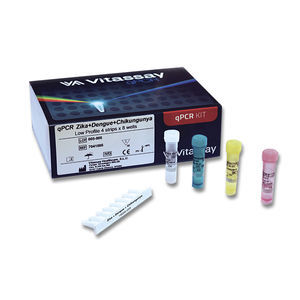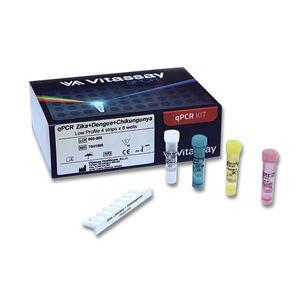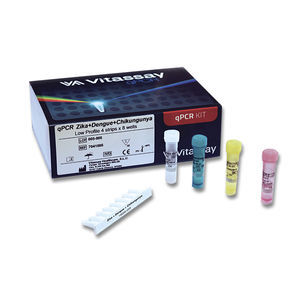
- Laboratory
- Laboratory medicine
- Zika virus test kit
- VITASSAY HEALTHCARE S.L.
Zika virus test kit 7041003 clinicallaboratorycutaneous
Add to favorites
Compare this product
Characteristics
- Applications
- Zika virus
- Sample type
- clinical, laboratory, cutaneous
- Analysis mode
- for real-time PCR
Description
Vitassay qPCR Zika allows the qualitative detection of Zika virus by real-time RT-PCR in clinical samples. The product is intended for use in the diagnosis of Zika virus infections alongside clinical data of the patient and other laboratory tests outcomes.
Transport and storage
• The reagents and the test can be shipped and stored at 2-40ºC until expiration date stated in the label.
• The resuspended positive control should be stored at -20ºC. In order to avoid repeated freeze/thaw cycles, it is recommended to distribute the content in different aliquots.
• Keep all reagents in the darkness.
Additional equipment and material required
• Real-time PCR instrument (thermocycler) (Attached I)
• RNA extraction kit
• Centrifuge for 1.5 mL tubes
• Vortexer
• Micropipettes (1-20 µL, 20-200 µL)
• Filter tips
• Powder-free disposal gloves
Summary
Zika virus (ZIKV) is an emerging mosquito-borne pathogen (family Flaviviridae, genus Flavivirus) that was isolated in 1947 from a rhesus monkey in the Zika forest in Uganda. ZIKV is believed to be transmitted to humans by infected Aedes spp. mosquitoes. Several studies have demonstrated that ZIKV is endemic to Africa and Southeast Asia. In fact, in other regions, Zika virus infections have been reported in few cases until 2007 when an epidemic of ZIKV infection in humans occurred in Yap Island and Federated States of Micronesia, in the Pacific region.
In humans, ZIKV infection is characterized by mild fever (37.8°C–38.5°C); arthralgia (notably of small joints of hands and feet); myalgia, headache; retroorbital pain; conjunctivitis; and cutaneous maculopapular rash.
Catalogs
Vitassay_Catalogue
20 Pages
Related Searches
- Assay kit
- Solution reagent kit
- Blood assay kit
- Molecular biology reagent kit
- Plasma assay kit
- Infectious disease detection kit
- Blood rapid diagnostic test
- Diagnostic reagent kit
- Rapid lateral flow test
- Enzyme reagent kit
- Immunoassay rapid diagnostic test
- Molecular test kit
- Cassette rapid diagnostic test
- Rapid virus test
- Respiratory infection test kit
- Optical assay kit
- Clinical assay kit
- Infectious disease rapid diagnostic test
- Buffer solution reagent kit
- Fluorescence assay kit
*Prices are pre-tax. They exclude delivery charges and customs duties and do not include additional charges for installation or activation options. Prices are indicative only and may vary by country, with changes to the cost of raw materials and exchange rates.





















